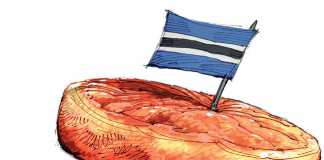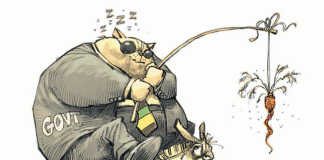The Unit for Risk Analysis, a specialist risk assessment team at the South African Institute of Race Relations, has described the proposed nationalisation of agricultural land in South Africa as a potentially “cataclysmic event” for South Africa’s economy. The government has responded to these and other warnings by denying any intention to nationalise private property.
We have reason to doubt their assurances. Our scepticism of the government’s denials is informed by three things.
A published proposal
The first is that nationalisation is now a written and published government policy proposal. The Department of Rural Development and Land Reform (DRDLR) has proposed two future land-use models in their Strategic Plan 2010 to 2013.
Their proposal says: “To facilitate this discussion, the department is proposing two options: all productive land will become a national asset and a quitrent land tenure system, either with perpetual or limited rights, is envisaged. This may require an amendment to Section 25 of the Constitution. All tenure legislation will be subsequently reviewed and brought under a single national land policy framework.
“Option two will focus on a review of current tenure policies and legislation in order to maintain the current free-hold title system but within the ambit of a land ceilings framework linked to categorisation of farmers.
“Option two will also investigate a Stand Land Management Board to facilitate the management of state-owned agricultural land and leases.”
Inherent in the first proposal is that ownership of “productive” land will rest with the state. The state would then have the authority to declare who could work the land, for what purposes, and under what conditions. The second proposal suggests placing a ceiling on how much land individual farmers can own.
The government and the DRDLR have responded to our warnings by saying that there is no plan to nationalise South Africa’s farms. The government has further stated that it respects private property rights and that this will not change.
However, government’s assurances are obviously contrary to their own written and published plan. While various officials have said that the plan does not talk about “nationalisation”, it does talk about private owners ceding control of their land to the state, which will then lease that land back to the farmers.
Government’s proposal also identifies the need to alter Section 25 of the Constitution, which deals with and guarantees private property rights.
Following a trend
A second reason to doubt government’s assurances is that this latest policy proposal appears to follow an established trend of the state seizing control of what it regards as important ”national assets”.
In 2002, through the Minerals and Petroleum Development Act, government took custodianship of all mineral rights in the country, thereby ending private ownership. Mining companies had to reapply for those rights in order to continue mining.
This legislative step did significant harm to the mining industry in the country and to investor sentiment, particularly in the mining sector.
Similarly, the government took control of all water resources in the country through the National Water Act of 1998. The previous distinction between public and privately owned water was eliminated, making all water a “public asset”. Water allowances were imposed and government handed itself the authority of managing the country’s water resources.
What we are now seeing in terms of government’s proposed land seizure scheme is therefore a logical progression of government policy.
A controversial Bill
The third reason to doubt the government’s sincerity is that this latest proposal appears to be a continuation of a pattern of thinking that gave rise to the Expropriation Bill of 2008. The institute published extensively on the Bill, which would have given the state the authority to seize any fixed or movable property “in the national interest” without paying compensation. Ahead of the 2009 elections, government declared that this controversial Bill would be shelved.
Government has recently admitted that nine out of every 10 land reform projects that it has managed have failed. Under these circumstances it is impossible that this same government will be able to successfully manage South Africa’s entire commercial farming industry.
This is particularly so if they erode the capital value in agricultural land, which is important collateral against which farmers can raise loans to run their businesses.
What are the consequences?
There is every likelihood that, if either of the two proposals goes ahead, South Africa will experience a steep reduction in agricultural investment. This will translate into a commensurate fall in agricultural employment, which will in turn drive up levels of rural poverty and provide an impetus for greater rural to urban migration.
As a result, South Africa’s ability to meet its food needs will be undermined. This will see knock-on effects on downstream food processing industries with corresponding falls in employment and investment. Upstream supply industries will see their markets shrink as demand for their products falls. South Africa will be forced to import more of its food needs, placing pressure on both the current account deficit and the food price inflation.
It’s uncertain to what extent government and the ANC identify these risks. Certainly they ignored similar warnings on skills, mining, health, education, security, electricity, and labour market policy, for which South Africa paid a heavy price. It is quite possible that the government may therefore proceed with this scheme only to try and reverse the policy as its negative effects become more apparent.
It’s also possible that the government may identify these repercussions but proceed regardless, in order to achieve what they may see as the more important end of breaking the back of white commercial agriculture and handing farms to black farmers.
On this score, the ANC leadership’s recent support for incitement by its Youth League to shoot and kill white Afrikaans farmers is pertinent. Certainly government’s attitude to white skills in the civil service suggests that they are willing to sacrifice performance for racial ideology.
We must also warn against regarding the second of the two proposals, to restrict the size of farms, as a lesser of two evils. Destroying the economies of scale that make South Africa’s commercial agriculture sector viable will result in precisely the same consequences as we have spelt out above.
Analysis shows that there are elements in government and Cabinet who are serious about nationalising commercial agriculture. We would therefore advise agricultural and related industries to take this policy proposal seriously, identify the likely consequences, and prepare for the eventuality of the state seizing all or part of South Africa’s agricultural land.
It’s necessary to be sceptical of assurances that the proposals are merely a mechanism for taking failed farms back from black farmers.
These assurances may turn out to be nothing but a ruse to conceal the state’s more plausible intention to wrest control of agricultural production from white commercial farmers. This is particularly plausible when viewed against government’s track record of nationalising mineral and water rights and in proposing legislation to seize any fixed or movable property without paying compensation.













